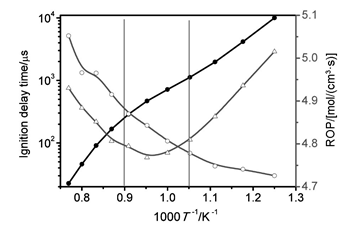| [1] Shao, J.-X.; Tan, N.-X.; Liu, W.-X.; Li, X.-Y. Acta Phys. Chim. Sin. 2010, 26(2), 270. (邵菊香, 谈宁馨, 刘伟雄, 李象远, 物理化学学报, 2010, 26(2), 270)
[2] Jiang, R.; Liu, G.; Zhang, X. Energ. Fuel. 2013, 27(5), 2563.
[3] Li, J.; Shao, J.-X.; Liu, C.-X.; Rao, H.-B.; Li, Z.-R.; Li, X.-Y. Acta Chim. Sinica 2010, 68(3), 239. (李军, 邵菊香, 刘存喜, 饶含兵, 李泽荣, 李象远, 化学学报, 2010, 68(3), 239.)
[4] Xu, C.; Konnov, A. A. Energy 2012, 43(1), 19.
[5] Suzuki, M.; Moriwaki, T.; Okazaki, S.; Okuda, T.; Tanzawa, T. Astronautica Acta 1973, 18(5), 359.
[6] Cadman, P.; Bambrey, R. J.; Box, S. K.; Thomas, G. O. Combust. Sci. Technol. 2002, 174(11-12), 111.
[7] Liang, J.-H.; Hu, H.-H.; Wang, S.; Zhang, S.-T.; Fan, B.-C.; Cui, J.-P. Chin. J. Theor. Appl. Mech. 2014, 46(1), 155. (梁金虎, 胡弘浩, 王苏, 张胜涛, 范秉诚, 崔季平, 力学学报, 2014, 46(1), 155.)
[8] Kumar, K.; Mittal, G.; Sung, C.; Law, C. Combust. Flame 2008, 153(3), 343.
[9] Metcalfe, W. K.; Burke, S. M.; Ahmed, S. S.; Curran, H. J. Int. J. Chem. Kinet. 2013, 45(10), 638.
[10] Zhou, C.-W.; Li, Y.; O'Connor, E.; Somers, K. P.; Thion, S.; Keesee, C.; Mathieu, O.; Petersen, E. L.; DeVerter, T. A.; Oehlschlaeger, M. A.; Kukkadapu, G.; Sung, C.-J.; Alrefae, M.; Khaled, F.; Farooq, A.; Dirrenberger, P.; Glaude, P.-A.; Bat-tin-Leclerc, F.; Santner, J.; Ju, Y.; Held, T.; Haas, F. M.; Dryer, F. L.; Curran, H. J. Combust. Flame 2016, 167, 353.
[11] Ranzi, E.; Cavallotti, C.; Cuoci, A.; Frassoldati, A.; Pelucchi, M.; Faravelli, T. Combust. Flame 2015, 162(5), 1679.
[12] Lopez, J. G.; Rasmussen, C. L.; Alzueta, M. U.; Gao, Y.; Marshall, P.; Glarborg, P. P. Combust. Inst. 2009, 32(1), 367.
[13] Prince, J. C.; Williams, F. A. Combust. Flame. 2012, 159(7), 2336.
[14] "Chemical-Kinetic Mechanisms for Combustion Applications", San Diego Mechanism web page, Mechanical and Aerospace Engineering (Combustion Research), University of California at San Diego (http://web.eng.ucsd.edu/mae/groups/combustion/mechanism.html).
[15] Guo, J.; Xu, J.; Li, Z.; Tan, N.; Li, X. J. Phys. Chem. A 2015, 119(13), 3161.
[16] Wang, H.; Laskin, A.; Djurisic, Z. M.; Law, C. K.; Davis, S.G.; Zhu, D. L. In Chemical and Physical Processes of Combustion, the 1999 Fall Technical Meeting of the Eastern States Section of the Combustion Institute, Raleigh, NC, October, 1999, pp. 129~132. http://ignis.usc.edu/Mechanisms/C2-C4/c2.html.
[17] Sabia, P.; Joannon, M. d.; Picarelli, A.; Chinnici, A.; Ragucci, R. Fuel. 2012, 91(1), 238.
[18] Merchant, S. S.; Goldsmith, C. F.; Vandeputte, A. G.; Burke, M. P.; Klippenstein, S. J.; Green, W. H. Combust. Flame 2015, 162(10), 3658.
[19] CHEMKIN-PRO 15092, Reaction design, San Diego, 2009.
[20] Kopp, M. M.; Donato, N. S.; Petersen, E. L.; Metcalfe, W. K.; Burke, S. M.; Curran, H. J. J. Propul. Power 2014, 30(3), 790.
[21] Penyazkov, O. G.; Sevrouk, K. L.; Tangirala, V.; Joshi, N. P. Combust. Inst. 2009, 32(2), 2421.
[22] Kopp, M. M.; Petersen, E. L.; Metcalfe, W. K.; Burke, S. M.; Curran, H. J. J. Propul. Power 2014, 30(3), 799.
[23] Goldsmith, C. F.; Harding, L. B.; Georgievskii, Y.; Miller, J. A.; Klippenstein, S. J. J. Phys. Chem. A 2015, 119(28), 7766. |
